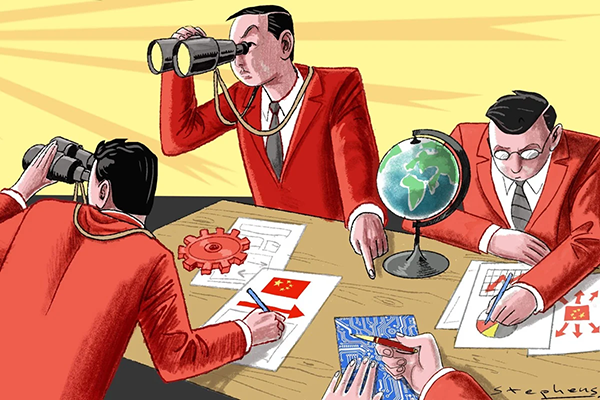Wang Huiyao: More cooperation, less competition
China Daily | January 19 , 2021
Opportunity for China and the US to reduce the trust deficit that has developed over the past four years
China-US ties have soured under the Donald Trump administration. But as well as challenges, there are also opportunities for the relationship under the incoming Joe Biden administration.
As the most critical bilateral relationship in the world, the trajectory of China-US ties will have profound implications for global peace and prosperity.
Since the establishment of official diplomatic ties in 1979, economic exchanges between China and the United States have benefited both countries enormously. Bilateral trade has increased 252 times in the past four decades, from $2.5 billion in 1979 to $633.5 billion in 2018. China’s high-quality and inexpensive goods have saved US families money, and US technology and capital have supported the development of various sectors in China.
However, at present, China and the US are facing a serious trust deficit, with more than 100 dialogue and exchange mechanisms suspended. To restructure China-US ties and boost mutual understanding, there is a need to build more dialogue mechanisms and enhance bilateral and multilateral cooperation while jointly addressing global challenges. Also, the strengths of various communities need to be harnessed to promote bilateral exchange. In particular, there are four areas in which both sides can work to promote mutual understanding and revitalize cooperation.
First, as the COVID-19 pandemic continues to wreak havoc around the world with record confirmed cases in many countries, China and the US should build a global anti-pandemic fund to support the World Health Organization and global anti-pandemic cooperation.
A G10 summit should be convened among the G7 countries, China, India and Russia to coordinate cooperation on research, development, production, procurement and the distribution of vaccines, and support less-developed countries with money, materials, technologies and personnel. As the pandemic continues to hit the world economy and international finance, China and the US should also work together, as they did in 2008, to protect the world from a disastrous economic crisis and ensure world economic stability and social development.
Second, there is excellent potential for China-US to cooperate to tackle climate change. China and the US can cooperate in international carbon trading mechanism reform, clean technology and energy research and development and disaster prevention and control. The two countries can also learn and apply lessons gleaned from China-EU cooperation and establish bilateral meetings on the digital economy and green cooperation.
Third, in terms of international trade, Biden may seek to join the Comprehensive and Progressive Agreement for Trans-Pacific Partnership sometime in the future. China has also suggested it may be open to joining. China and the US might therefore be able to negotiate on the CPTPP and World Trade Organization reform to improve global economic and trade rules. In the future, the CPTPP could also serve as a platform for China-US exchanges. Meanwhile, the conclusion of negotiations on the China-EU Comprehensive Investment Agreement provides opportunities to restart negotiations on the China-US Bilateral Investment Treaty that they started in 2008 but failed to reach consensus on. In addition, the US is welcome to participate in the Regional Comprehensive Economic Partnership and work on jointly restructuring economic and trade rules in the Asia-Pacific region.
Deepening exchanges between China and the US will help both sides manage conflict, find a way to coexist peacefully and seek common ground despite their differences.
At the official level, China and the US should strive to resume some high-level dialogue mechanisms. A new China-US-Europe dialogue mechanism could be established to deal with their relations and global governance issues.
Non-governmental organizations, such as think tanks, can operate in a flexible manner and play an important role in propelling Track II Diplomacy between China and the US. People-to-people exchanges can also help energize China-US relations. Particularly, the young of both sides need to play a greater role in China-US exchanges and the international community should establish more youth exchange mechanisms.
In the past, China and the US enjoyed flourishing cultural exchanges. When the pandemic is brought under control, entry restrictions should be relaxed to welcome more people from the US to China for study, tourism, and cultural and academic exchanges so that people of all ages and fields can better understand China.
In the second half of the 20th century, the world was divided into two camps, one aligned to the US and the other to the Soviet Union. A spiraling arms race between the two powers and mutual hostility caused negative spillover effects which still linger in the minds of some people, convincing them that international competition is a zero-sum game.
In the 21st century, with the rise of the China-US “decoupling” rhetoric and anti-globalization sentiment, globalization has come to a crossroad. But the China-US relationship is not a replica of the US-Soviet relationship. By seizing opportunities, the US and China can forge a relationship that combines healthy competition with joint bilateral and multilateral efforts to address global challenges.
Recommended Articles
-

Wang Huiyao: Key lessons from China’s ascent over the past 25 years
-
Wang Huiyao: China and Latin America: Partners in a shared new era
-
Wang Huiyao: Only a multipolar coalition can secure Ukraine peace
-
Wang Huiyao: How to Fix the Security Council
-
Wang Huiyao: Critics are missing the big picture on China’s economic transition